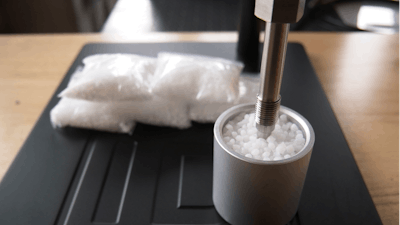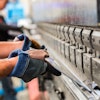
Many large chemical facilities have an internal testing laboratory to manage the analysis of polymers for use in a wide variety of materials and products.
If this option is not available, operators can send samples to external, third-party labs for on-demand analysis. The analytical data is critical for operators to make informed decisions regarding product quality, infrastructure protection, regulatory compliance and other key factors that ultimately impact profitability.
Chemours is a chemistry company which produces materials that help firms solve challenging problems related to polymers, pigments and cooling fluids.
The company continually develops new polymer materials and new applications for existing materials. This requires measuring properties of the materials to ensure proper function.
Consequently, during production the company measures its process to maintain tight control, according to Troy Francisco, Technology Manager, Chemours Discovery Hub and team leader for the leveraged analytical group and the process analysis group.
“We provide measurements and analysis for R&D, to evaluate our processing and to ensure we are being good stewards of our environment – and effectively using Raman spectroscopy is essential in these efforts,” said Francisco.
 Technological improvements in lasers, optics, and detectors have made the Raman technique faster and more accessible.MarqMetrix
Technological improvements in lasers, optics, and detectors have made the Raman technique faster and more accessible.MarqMetrix
Raman Spectroscopy
Raman spectroscopy is a laser-based optical analysis technique used to measure composition through the vibrational properties of molecules.
Samples are collected using a 785nm excitation laser and a contact probe that produces a unique spectral fingerprint that identifies the chemical composition and molecular structure.
The distribution of the spectral peaks describes the molecule’s composition, while the signal intensity correlates linearly with concentration.
Since its discovery in the 1920s, Raman spectroscopy has revolutionized process analysis with its nondestructive mode of operation and capability to measure sample composition.
However, the broader adoption of this technique is the result of advancements in the stability and portability of solid-state Raman systems and technological improvements in lasers, optics and detectors that have made the technique faster and more accessible.
“Raman spectroscopy is a well-established technique that complements everything else in the testing lab,” said Francisco. “It is vital for any application related to the compositional analysis of polymers, which is important at Chemours. We also find that it useful for the compositional analysis of reactants going into a chemical reaction.”
“The technology is also very good at telling us what the different forms or purity levels are in inorganic, solid state or mineral type materials and can help to identify impurities in those materials,” he adds.
For many years, however, Raman equipment has had a reputation for being expensive, cumbersome and difficult to use. Now, advancements in the stability and portability of certain Raman systems and technological improvements in lasers, optics and detectors have made the technique faster and more accessible for real-time inline measurements as well as laboratory testing.
According to Francisco, Chemours had previous experience with two different Raman systems. He describes one as a “a low end, qualitative type system” that did not have great stability in terms of response or signal, nor great stability with respect to the wavelength access or its registration.
“[The low-end system] was useful for rough measurements, but was not a high fidelity, scientific instrument,” said Francisco.
The other system that Chemours utilized was a high-quality R&D level instrument, but it required considerable attention and frequent calibration. Francisco found it difficult to keep up with the maintenance required for the Chemours applications.
In addition, the system was quite costly “so we not only had to work more, but also had to pay more,” said Francisco.
Over time, Francisco monitored the development of Raman spectroscopy and selected easy-to-use commercial technology by Seattle-based MarqMetrix.
Founded in 2012 by scientists from the University of Washington, the company specializes in compositional analysis utilizing Raman spectroscopy and has pioneered advancements in Raman for use in process analysis.
“When we recently needed to upgrade our Raman analyzer technology, I saw that MarqMetrix equipment really fit our requirements in terms of size, stability, application and ease of use,” said Francisco.
According to Francisco, the Raman equipment provides an unusual combination of compactness with stability.
As an example, MarqMetrix engineered the All-in-One to produce identical and repeatable results from unit to unit, in a package 80% smaller than previous Raman instruments.
Each device is nearly an exact copy so common mathematical models can be applied across systems to produce consistent results.
“The small package works beautifully and the computing front end includes everything we need,” said Francisco.
 The Raman system works with a wide array of contact probes suitable for compositional analysis applications.MarqMetrix
The Raman system works with a wide array of contact probes suitable for compositional analysis applications.MarqMetrix
The system works with a wide array of contact probes suitable for compositional analysis applications that can be changed in seconds, without the need for recalibration.
MarqMetrix manufactures a wide range of standard and custom probes to measure compounds in any form, including solids, liquids, gases, slurries, pastes and gels.
Traditionally, Raman spectroscopy requires the accurate and precise ongoing focusing of the laser onto the sample by the operator for repeatable analysis, which can slow productivity and introduce human error.
To streamline the process and increase reliability, MarqMetrix probes eliminate the need for the operator to focus the laser. This enables the user to simply touch the sample and get the same reproducible measurement every time with accuracy of +/- 0.1%.
“The probes are the only component that touches or interacts with the sample itself, so we have purchased ball, proximal and flow cell probes to ensure we have all the options in our toolbox,” said Francisco.
The new Raman systems are designed to be quick and easy to use right out of the box.
“When we received our [MarqMetrix] system, we unpacked the box and were collecting Raman measurements within 10 to 15 minutes. I have never seen that before with a Raman system. The level of simplicity and accessibility is unheard of with this type of equipment,” said Francisco.
Although the MarqMetrix Raman equipment can be used to identify the components within approximately 15 minutes of unboxing, quantifying the concentrations of each component first requires creating a predictive model. For general laboratory use, MarqMetrix offers a library of pre-developed models that covers most common applications.
“In a manufacturing environment, [we use] a model that runs on a continuous basis and predicts properties related to the process that we are monitoring,” explains Francisco. “So, if we are looking for the composition of a polymer, the model could depict how to turn the Raman spectrum into the weight percentage of different monomers that comprise the polymer.”
Selecting the advanced technology has also resulted in significant cost savings.
“Compared to the more expensive Raman system we used previously, our MarqMetrix All-in-One cost at least 50% less,” said Francisco.
The versatile Raman technology is providing Chemours with the flexibility to measure and analyze polymers as needed, according to Francisco.
 Improvements in lasers, optics, and detectors have made the Raman technique faster and more accessible for real-time inline measurements.MarqMetrix
Improvements in lasers, optics, and detectors have made the Raman technique faster and more accessible for real-time inline measurements.MarqMetrix
“We have found that Raman is also a very nice standalone technique that compliments everything else in the lab. It is not only a new technology for established applications, but also a flexible technology that finds its own niche in the laboratory,” concluded Francisco.
Accurate measurement is more essential than ever in the polymer industry. Understanding the chemical composition of raw materials and the consistency of processed products is the key to manage processes, reduce risks and maximize outcomes.
With the advancements in applying Raman spectroscopy systems to sample measurement, laboratories now have a reliable and economical tool that produces accurate, fast results and complements existing testing methodologies.























